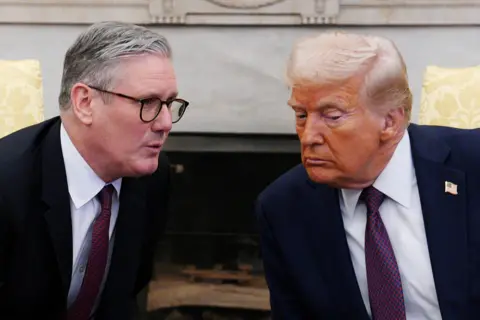In a recent development regarding trade relations, the United States and the United Kingdom have reached an agreement that, while deemed economically modest, has significant implications for the UK’s future trade arrangements, particularly with the European Union (EU). This diplomatic achievement allows the UK to pursue a comprehensive deal with the EU—potentially centering around food standards—without the constraints that have previously encumbered such negotiations.
At its core, the US deal appears small in the broad spectrum of trade but holds specific importance for distinct sectors within the UK economy. One significant outcome is the rollback of some of the trade repercussions that arose from former President Donald Trump’s policies, particularly those impacting the automotive industry. According to industry insiders, the reduction of tariffs from 27.5% to 10% signifies a crucial reprieve for UK car exporters, potentially saving them over £1 billion and alleviating what was described as an “existential threat” to the industry.
It is imperative to address, however, that while the immediate danger to the car industry has been mitigated, challenges remain. The new agreement brings with it a quota system that lacks clarity, particularly concerning how it will incorporate foreign components, such as Chinese batteries. Furthermore, the quota is limited to just 100,000 cars, posing limitations that may affect the launch of new models, such as Jaguar’s recent endeavor into the US market, which anticipated a higher volume of exports.
Conversely, this agreement opens the door for US agricultural products, including beef, to enter the UK market—though this access too is governed by quotas. Notably absent from the deal were movements on digital service taxes or tariffs concerning American vehicles, which points to a perceived imbalance in the negotiations. The retention of the 10% reciprocal tariff remains a contentious issue, considering that it stands despite the UK importing more from the US than vice versa, underscoring the deal’s inherently one-sided nature.
Commerce Secretary Howard Lutnick’s presentation at the White House led to speculation about the nature of the agreement—as if the UK had granted “unprecedented access” solely to protect its automotive sector, showcasing a kind of leverage that may not bode well for future negotiations. While the US tripled its tariffs on UK goods—from 3.4% to 10%—the UK has considerably reduced its own tariffs from 5.1% to 1.8%, raising questions about the reciprocity of this agreement.
From a broader economic perspective, these differing interpretations of the tariff dynamics illustrate a stark divergence in how trade relationships are viewed across the pond. For the US, increased tariffs represent a revenue gain for the Treasury, whereas, in the UK, these tariffs translate as a burden on domestic consumers, exacerbating inflation. This volatility in consumer economics is one reason the Bank of England is seeing a more gradual incline in inflation rates, enabling recent interest rate cuts.
Governor Andrew Bailey expressed optimism that this agreement could herald a new era of reduced global trade tensions, which would benefit economic stability. The most significant win here may be that by addressing US tariffs, the UK has positioned itself favorably for substantive negotiations with the EU—its largest trading partner. By retaining UK food standards, avoiding the inclusion of hormone-treated beef or chlorinated chicken, the potential for a comprehensive trade deal similar to Switzerland’s is more tangible.
As the UK contemplates its international trade strategy amidst evolving geopolitical landscapes, it appears poised for a period of economic growth supported by robust trading relationships with not only the US and EU but also regions such as India and the Gulf states. This shift might project the UK as a beacon of stability and trade resilience in a time of global unrest, fundamentally transforming its narrative from one of recessionary fears to one of vibrant economic opportunity.



